| |
Click on the maps for larger image |
| |
|
| Regional Surface Meteorological Networks |
| |
|
| WFIE WeatherNet
- WFIE-TV in Evansville, Indiana operates this network of 14 stations located
primarily at schools throughout southwestern Indiana and western Kentucky
(7 in Kentucky). The
network provides up to 1-minute observations of air temperature, relative
humidity, wind speed, wind direction, precipitation, and barometric pressure.
For further information visit the
WFIE
network page. |
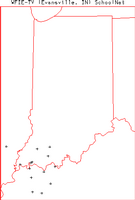 |
| WTVQ WeatherNet
- WTVQ-TV in Lexington, Kentucky operates this network of 39 stations located
primarily at schools throughout Kentucky and 1 station in Indiana. The
network provides up to 1-minute observations of air temperature, relative
humidity, wind speed, wind direction, precipitation, and barometric pressure.
For further information visit the
WTVQ network page. |
No map yet. |
| WCYB WeatherNet
- WCYB-TV in Brisol, Tri-Cities, Virginia operates this network of 59 stations located
primarily at schools throughout Virginia, Tennessee, North Carolina and one in Kentucky. The
network provides up to 1-minute observations of air temperature, relative
humidity, wind speed, wind direction, precipitation, and barometric pressure.
For further information visit the
WCYB network page. |
No map yet. |
| |
|
| State and Local Surface Meteorological Networks |
| |
|
| Kentucky Mesonet - The Kentucky Climate Center at Western Kentucky
University is overseeing the development of this network of environmental monitoring
stations throughout Kentucky. For further information visit the
Kentucky Mesonet web page. |
No map. |
| |
|
| Kentucky Roadway Weather Information System
(RWIS) - The Kentucky Transportation Cabinet operates this network of 39 stations
with locations throughout the state of Kentucky. The network
provides variable (hourly or higher) resolution observations of air
temperature, dew point, relative humidity, and wind speed. For further information
visit the Kentucky
RWIS home page.
This network is included in the NOAA/FSL MADIS
data set. |
 |
| |
|
| Kentucky Air Monitoring Network - The Kentucky
Department for Environmental Protection operates this network of 13 stations at
locations throughout the state of Kentucky. All stations provide hourly observations
of wind speed and wind direction. Some sites also provide other meteorological
parameters. For further information visit the
Division for Air Quality page. |
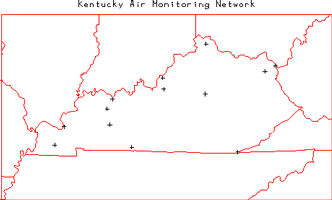 |
| |
|
| Louisville Ambient Air Monitoring Network - The Louisville Metro Air
Pollution Control District operates this network of 9 air monitoring stations throughout
Louisville. It is unknown how many of these provide meteorological observations. For
further information visit the
Louisville Metro Air
Pollution Control District Ambient Air Monitoring page. |
Map at web site. |
| |
|
| University of Kentucky Research Farms Network
- The University of Kentucky operates this network of 5 stations with locations in
central Kentucky. The network provides hourly observations of air temperature,
precipitation, relative humidity, soil temperature (at 4, 8, and 18 inch depths),
soil moisture (same depths), solar radiation, wind speed, and wind direction.
For further information visit the
Kentucky
Agricultural Weather Center. |
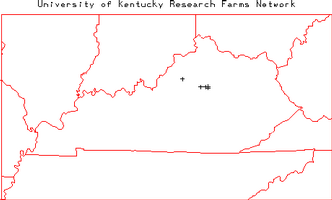 |
| |
|
| WKYT WeatherNet
- WKYT-TV in Lexington, Kentucky operates this network of 30 stations located
primarily at schools throughout central Kentucky. The
network provides up to 1-minute observations of air temperature, relative
humidity, wind speed, wind direction, precipitation, and barometric pressure.
For further information visit the
WKYT
network page. |
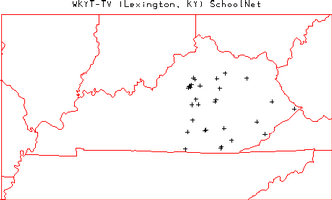 |
| |
|
| WHAS WeatherNet
- WKYT-TV in Lexington, Kentucky operates this network of 5 stations located
primarily at schools throughout central Kentucky. The
network provides up to 1-minute observations of air temperature, relative
humidity, wind speed, wind direction, precipitation, and barometric pressure.
For further information visit the
WHAS
network page. |
No map. |
| |
|
| Precipitation and Radar Networks |
| |
|
| NOAA/National Centers for Environmental
Prediction (NCEP) Hourly Precipitation Data - NOAA/NCEP routinely develops
a National Multi-sensor Hourly Precipitation Analysis (Stage II) data set from
hourly radar precipitation estimates and from hourly gage reports. The gage data
includes hourly observations from ~4000 gages across the US (83 in Kentucky)
collected by the NOAA River Forecast Centers and sent to NCEP. Further information
on these data is available at:
http://wwwt.emc.ncep.noaa.gov/mmb/ylin/pcpanl/. |
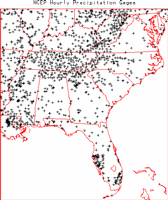 |
| |
|
| NOAA/NWS Cooperative Observer 15-minute Precipitation Network - The
NOAA/NWS routinely collects 15-minute observations of precipitation from Fisher-Porter
and Universal rain gages operated by 2777 cooperative observers located throughout the
US (63 in Kentucky). These data are archived at NOAA/NCDC as data set TD 3260. For
further information visit the NOAA/NCDC TD3260 page at:
http://ols.nndc.noaa.gov/plolstore/plsql/olstore.prodspecific?prodnum=C00505-TAP-A0001 |
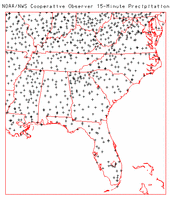 |
| |
|
| Integrated FLood Observing and Warning System
(IFLOWS) Precipitation Network - The IFLOWS precipitation network is a collection
of various state operated Automated Flood Warning System (AFWS) networks throughout
the mid-Atlantic and northeastern portions of the United States. The network is
comprised of 1530 precipitation stations that provide 15-minute observations of
precipitation (178 in Kentucky). These precipitation data are included as part of the NCEP
Precipitation data set described above. For further information visit the
AFWS home page. |
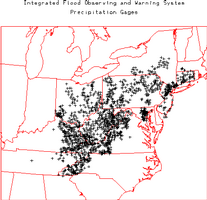 |
| |
|
| Jefferson County Rain Gauge Network -
Jefferson County, Kentucky operates this network of 45 rain gauges with locations
throughout the county (located in north-central Kentucky around Louisville). The
network provides 5-minute observations of rainfall. For further information visit
the
network page. |
Map on web page. |
| |
|
| Tennessee Valley Authority (TVA) Precipitation Network
- TVA operates this network of 243 precipitation gages throughout its service
area in the southeastern US (6 in Kentucky). The network provides 6-hourly observations
of precipitation. For further information visit the
TVA home page. |
 |
| |
|
| Weather Surveillance Radar 1988 Doppler (WSR-88D)
Network - The NOAA/NWS and the Department of Defense operate this network
of 143 WSR-88D radars across the contiguous US (4 in Kentucky). The Level II
data are the three meteorological base data quantities (reflectivity, mean radial
velocity, and spectrum width) and are recorded at all NWS and most DOD sites.
Level II data are then processed in order to create a number of meteorological analysis
products known as Level III data. Level III data are recorded at the NWS sites. The
Level III products included base reflectivity, base spectrum width, base velocity,
composite reflectivity, echo tops, velocity azimuth display (VAD) wind profile,
vertically integrated liquid (VIL), 1-hour precipitation, storm total precipitation,
hail index overlay, mesocyclone overlay, severe weather probability overlay, storm
structure, storm tracking information overlay, and tornadic vortex signature overlay.
All Level II and III data are archived at NOAA/NCDC. For further information visit
the NOAA/NCDC Radar Resources page at:
http://www.ncdc.noaa.gov/oa/radar/radarresources.html or the NOAA Radar
Operations Center at:
http://www.roc.noaa.gov/. |
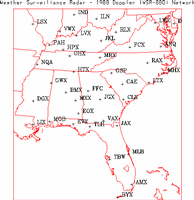 |
| |
|
| Radiation and Flux Networks |
| |
|
| None at present. |
|
| |
|
| Soil Networks |
| |
|
| Soil Climate Analysis Network (SCAN) - The SCAN is operated by the United
States Department of Agriculture (USDA) Natural Resources Conservation Service (NRCS). The
network provides hourly observations of air temperature, relative humidity, wind speed,
wind direction, solar radiation, precipitation, barometric pressure, snow water content,
snow depth, soil temperature (at 2, 4, 8, 20, and 40 cm depths), and soil moisture (at 2, 4,
8, 20 and 40 cm depths). The 80 SCAN stations are located across the US in primarily
agricultural regions (1 in Kentucky). For further information visit the
SCAN home page. |
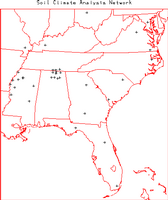 |
| |
|
| Hydrology Networks |
| |
|
| United States Geological Survey (USGS) Streamflow
Network - The USGS (part of the US Department of the Interior) operates this
network of 7237 streamflow gages (143 in Kentucky) at locations throughout the US.
The network provides hourly or more frequent observations of stage (water level) from
which discharge (flow) is computed using a stage-discharge rating relation. The
rating is defined by occasional direct current-meter measurements of discharge. All
data are available through the USGS and the district offices in each state. Many of
these gages provide realtime data
relayed via the GOES satellite data collection system. The realtime data are
provisional data that have not been reviewed or edited. These realtime data
may be subject to significant change and are not citeable until reviewed and approved
by the USGS. Realtime data may be changed after review because the stage-discharge
relationship may have been affected by: 1) backwater from ice or debris; 2) algal and
aquatic growth in the stream; 3) sediment movement; and 4) malfunction of recording
equipment. Each station record is considered provisional until the data are
published. The data are usually published with 6 months of the end of the water year
(1 October to 30 September). Data users are cautioned to consider carefully the
provisional nature of the information before using it. For further information on the
USGS streamflow network visit the
USGS Water Resources of the United
States page or the
USGS Kentucky District Office
home page. |
 |
| |
|
| Integrated FLood Observing and Warning System
(IFLOWS) Streamflow Network - The IFLOWS network is a collection of various
state operated Automated Flood Warning System (AFWS) networks throughout the mid-Atlantic
and northeastern portions of the United States. The network is comprised of 275
streamflow gages that provide 15-min stage observations (7 in Kentucky). For
further information visit the
AFWS home page. |
 |
| |
|
| Upper Air Networks |
| |
|
| Ground Based Global Positioning System (GPS) Meteorology Demonstration Network
(GPS-MET) - The NOAA/FSL ingests data from 323 GPS locations around the US
operated by many different agencies (1 in Kentucky). Typically each location provides
30-minute observations of integrated precipitatable water along with a number of surface
meteorology parameters (air temperature, relative humidity, barometric pressure, etc).
For further information visit the
GPS-MET home page. |
 |



























